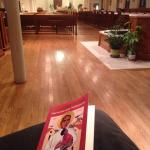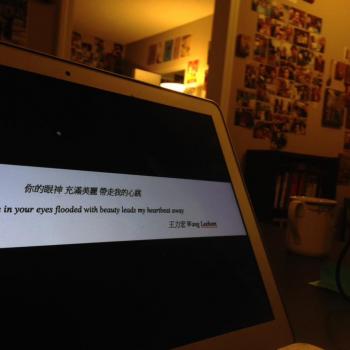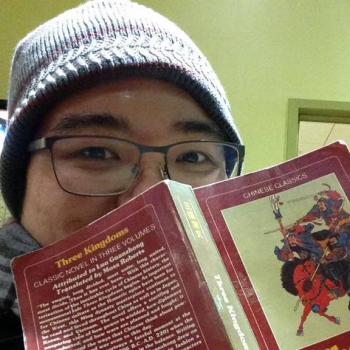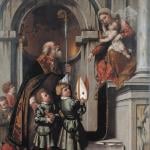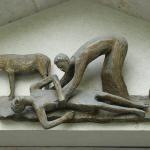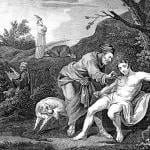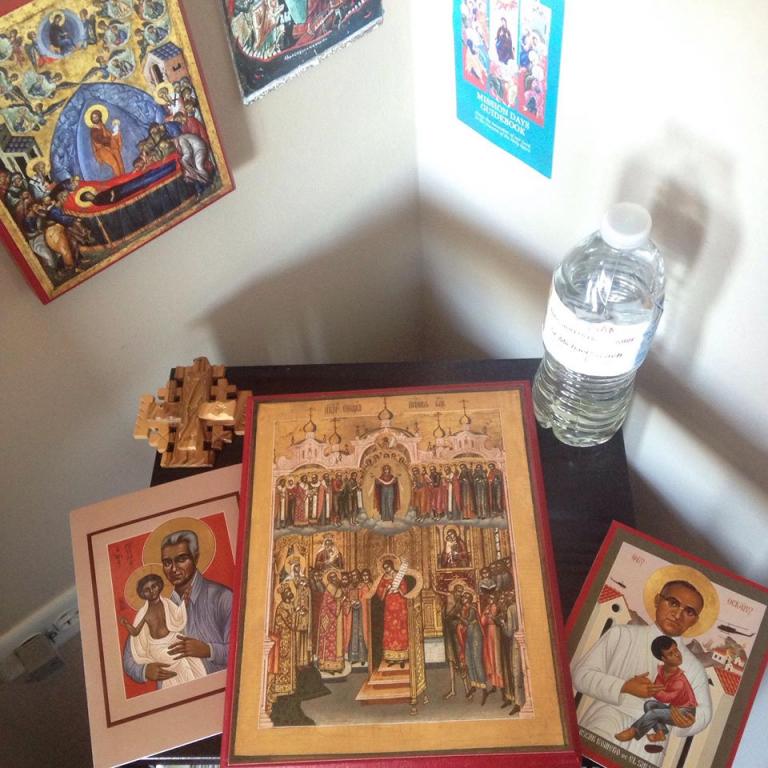
These are my reflections on the canonization of Archbishop Oscar Romero in our sister Latin Church on this Old Calendar Feast of the Protecting Mantle of the Most Holy Theotokos in our church.
On the night in 2016 that gave the world Donald Trump as President of the United States, I re-committed myself to Christian scholarship. It was a bleak night, and my spiritual father was online with me. I wrote about the experience then, of him asking me whether I wanted to be a Christian scholar and me telling him that I was done with the identity politics of Christianity. He told me then that he could only help me if I wanted to think in Christian terms about the whole situation and sent me two gifts. The first was a speech delivered by the New-Martyr Ignacio Ellacuría SJ about the role of the university in its local community. The second was the music of the Argentinian muse Mercedes Sosa, particularly the song ‘Sólo le pido a Dios,’ a cry to God that we do not forget the pain of the suffering but always feel it as our own as a motivator to work for justice. I realize now that my spiritual father had a personal connection to the Salvadoran New-Martyrs, including Ellacuría and his companions, Archbishop Oscar Romero, and Rutilio Grande SJ. He had been posted there for a ministry stint in the 1980s too.
I made my re-commitment to Christian scholarship that terrible election night because my spiritual father’s references to El Salvador and the struggles for liberation in Latin America reminded me of the 1989 film Romero, the one that stars Raul Julia as the Archbishop. Some people tell me they don’t like that movie because it plays down the suffering of the people of El Salvador. I get it; it’s a movie, nothing like the actual experience for those who have lived it. But I am blessed not to have lived it as a suburban boy from Fremont, so it was my first exposure to who Archbishop Romero was when I was fifteen. I watched it at the Catholic high school in a sophomore class on Christology. The teacher had been educated at the Jesuit theological school in Berkeley, and he said that he had known one of the guys portrayed in the film, the one who meets an ugly death when they electrocute him by the testicles. He was a quiet guy, my teacher said. It was a real shock when I learned that that’s what happened to him.
The arc of the film as I remember it – it has been over fifteen years since I’ve seen it – is that Archbishop Romero transforms from bookish to a man of the people. I am a man of books, I recall the Romero character saying in his first public address as portrayed in the film, and it soon cut to a scene of him in his study. As the film progressed, the horrors unfolded. This friend of Romero gets killed, then another one, and another. Each progression opens the world out a little more for Romero, and the more he sees, the more he understands that it is the political order of El Salvador that is unjust, that the establishment to which he had been comfortably allied was basically a killing machine that was picking off his friends. He gets closer and closer to the common people, and as more and more of them become his friends, he protests the regime for its repression. At one poignant point toward the end of the film, he stands in the way of the military by saying mass for the people. At the end, he is dramatically killed, shot with the chalice upraised so that his blood is co-mingled with the Blood of Christ.
I hear that the assassination of Archbishop Romero actually took place in the middle of a homily. This fact does not dampen Romero’s deep identification with Christ in the circumstances of his martyrdom. The sermon that he was interrupted in preaching concerns a woman who was killed for her dedication to the cause of social justice. The killing occurs at the high point of the oration, when Romero argues that she is deeply identified with what the Eucharist is about. He may not have been consecrating the chalice at the time of his death, but he certainly was talking about it.
There is something poetic about Archbishop Romero being murdered while delivering an exegesis of the Eucharist. The movie has to dramatize his death so that he dies as he is holding the chalice aloft because it would be far less dramatic if only his words were about the Blood of Christ. But Romero, as we learn even from the film, was a man of books. It was his scholarship, I’d like to suggest, that got him killed. Weekly, he delivered addresses about those who were being murdered and called on the regime to end the repression. These are exegetical statements. He was making plain what was going on, methodical in his scholarly approach, except that it was not longer written texts that he was explicating, but living ones and even inhuman systems. His parting words exegeted Christ himself in the Eucharist as it ran through the veins of a woman whose blood was spilled for the sake of justice. His life ended in exegesis, his body the open book that demonstrates his own identification with the crucifixion of the Messiah God.
Last week, with today’s canonization unbeknownst to the two of us, I visited Richmond, and my spiritual father preached on the Salvadoran martyrs in an explication of the Holy Evangelist Luke’s story of the Lord raising the son of the widow of Nain. Material justice, he reminded us, is part of the plan of salvation. He was there in El Salvador for some of it in the 1980s and even advocated for Romero’s canonization later on, but still we did not know it was happening until a few days ago. My dear friend Eugenia Geisel teased both of us, saying that our ignorance of events in the Latin Church prove that we truly are Greek Catholic, or rather, Orthodox in fact. Truly, then, are we autocephalous from Rome, and certainly, I have even waxed critical of the Bishop of Rome’s handling of challenges in the Latin Church of late, and not only the sexual ones.
While I am not cynical enough to see today’s canonizations as a way to spin the Vatican out of the mess that it’s in, I do think that Francis is telling us more about his relationship to the Salvadoran martyrs than he wants to let on. That line of inquiry has amply been explicated in The Atlantic by Paul Elie yesterday, and the conclusion that I drew from his story was that Francis has always been a moderate company man. In the face of Romero, Grande, and Ellacuría and those who died with them, he probably feels guilty about his moderation. Certainly, there is no story with integrity that could cast Francis as a martyr himself, at least not yet. There is always redemption, though. The theologian Jon Sobrino SJ writes in his reflections on Romero that when the Archbishop was first elected, courage was not the first word that folks used to describe him. He was conservative and coy. Only with the death of his friend Rutilio Grande was a fire lit from under him.
There is, at least in the way that my spiritual father tells it, a way in which the story of the Salvadoran martyrs, including Archbishop Romero but not only him, can be told as a narrative of conversion to the scholarship of everyday life, for which they were killed. They began, one might say, in an ivory tower, and maybe more than one. Trained in a conservative church to eschew critique of institutional systems and in textual analyses that do not readily lend themselves to the exegesis of the world, Grande, Romero, and the Jesuit martyrs show that the first step in intellectual conversion is the opening of their eyes to what is in front of them. As Sobrino notes in his reflections, the accusation that Romero was somehow manipulated by left-leaning Jesuits is false. Romero, for all intents and purposes, kept his Latin orthodoxy, if not his conservatism, fixated as he was on the Eucharist, being the local office of the magisterium, and working as a bishop. His conversion to the church of the poor occurred not by the infusion of ideology into his thinking, but by the shattering of his hall of mirrors. He was a man of books, but he realized that he was also a man among men, a person among persons, a human being alive with the glory of God among the icons of the bodies of the poor.
This turn to everyday life is not the abandonment of scholarship. It is its fulfillment. It is the realization that what a scholar should be studying is not simply books, but that what is in the book is an attempt to convey life as it happens. The writing of books is a challenge to the book knowledge, and there can always be more books written because there is always more life to live. But this turn is dangerous. It is what got Romero and those under his omophor, his mantle of authority, killed. The knowledge on which they began to act, aligning the institutions of the church and the university with the poor instead of the establishment, threatened the ideological order. Where is the scholar of this age? the anti-intellectual might ask, thinking to channel the Holy Apostle Paul. True scholars, we who make our living in the academy might answer, are among the poor, living with them our life together.
This life, one might say is the city, and it is poignant that it is on this day, the Feast of the Protection of the Most Holy Theotokos, that not only Romero, but the Holy Bishop of Rome Paul VI is being canonized. Paul VI might be said to have given words to what Romero and his companions were doing with the words civilization of love, that in a world of injustice and evil, they were already building an alternative order as pastors and scholars. A city needs scholarship; it is our job, after all, to educate and to maintain the autonomy of the intellect in order to keep the establishment honest and political agency where it belongs — with the people. But what it means to be a scholar is to be so invested in the reflection of everyday life that what emerges is a conscious building of a social ordering of life based on charity. That kind of thing, however, is constantly under threat, especially as intellectuals tend to have no armies. When violence comes at us — as it did for Romero, as it did for his companions and those under his omophor, and indeed as it also came for Paul VI himself when his friend Aldo Moro was killed — we must have a protector.
Here, the scholars of the everyday lives in the fragile project of building a civilization of love are most identified with the poor. It was not an intellectual or a politician or a bishop or a powerful person in the Church of Blachernae on the outskirts of Constantinople that saw the Mother of God descend from the dome in the middle of Vespers while the city was besieged by the pirates of Rus’, come to the ambo in tears, take off her mantle, and spread it over the people in protection. It was a Holy Fool-for-Christ — his name was Andrew — and the stichera and tropars of our celebration of Pokrov, the Protection of the God-bearer, speak constantly of him, joining the voices of theologians to the vision of someone who was regarded as the idiot of his society. Not only that, it is we in the Church of Kyiv, the descendants of those who had been besieging the Holy City, who celebrate the Pokrova more than the Greeks, who appear to have forgotten it.
Behold, then, the image that is presented to us on this Feast of Pokrov. Beneath Oscar Romero’s omophor is the poor, and he is killed for aligning his pastoral and scholarly orientations with them. But he stands beneath the omophor of another who is canonized today, Paul VI, whose civilization of love is revealed to be a city always under threat, even in his own everyday life from the threats of organized crime in Italy. What makes these martyrdoms worth it, then? Is the kingdom of God a possibility in our midst? Can we build this city in which we profess faith? Pokrov is the answer, because Paul VI, Oscar Romero, and all who dare to align themselves with the poor in the scholarship of everyday life are under her omophor, and through her protection, the city will not be taken.

